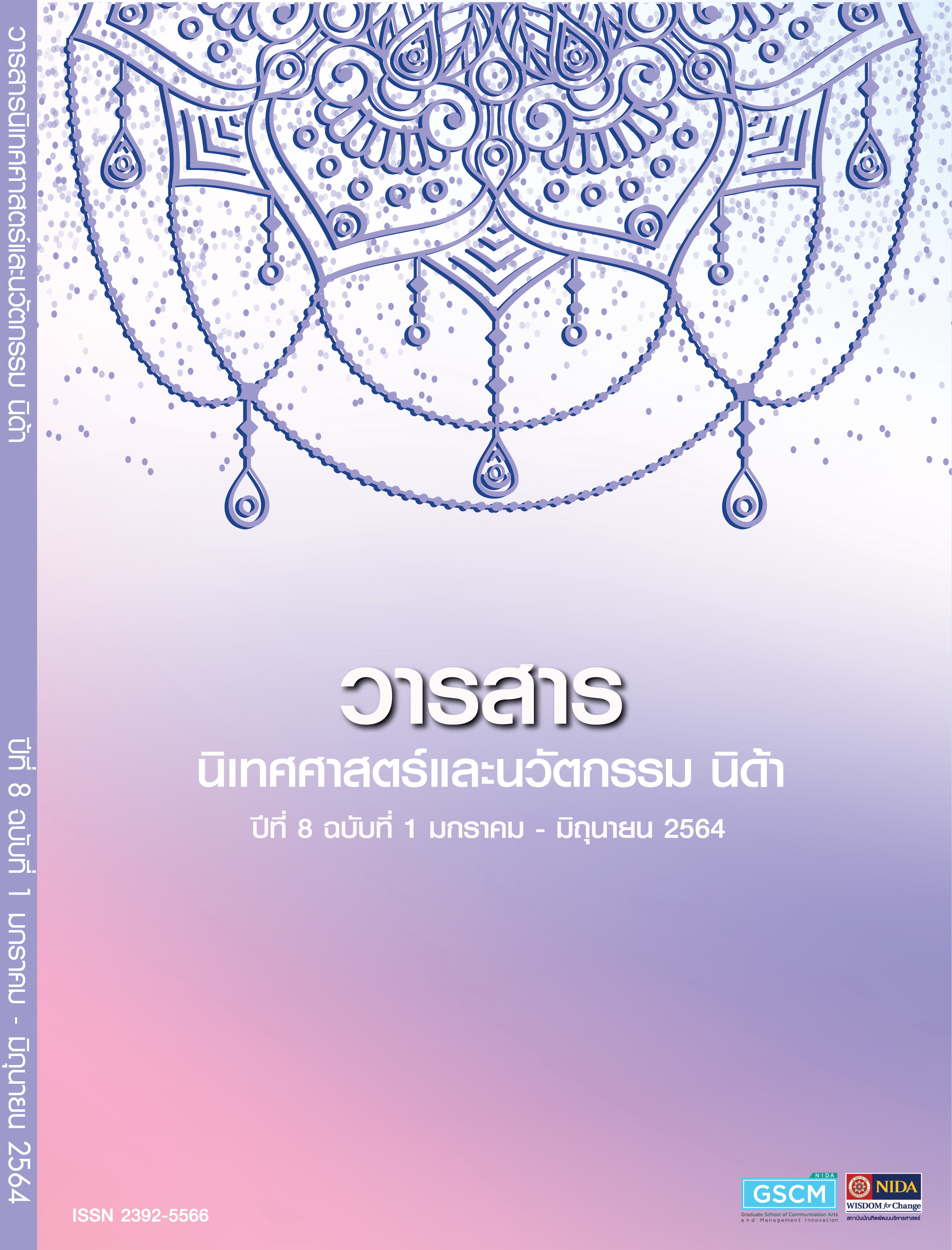The Study Digital Technology’s Perception and Ability Level of Elderly in Bangkok
Main Article Content
Abstract
The objective of this research is to study the level of elderly’s ability in digital media technology usage in Bangkok. The main purposes are 1) To study the knowledge of elderly’s digital technology usage, 2) To study the ability of elderly’s digital technology usage and 3) To compare the differences in the demographic characteristics of the elderly and their knowledge and ability to use digital media technology. 4) To study the relationship between the knowledge and the ability of digital technology usage of elderly in Bangkok.
The process of data collections was collected from the elderly who are living in Bangkok area by multistage sampling research technique. The statistical research techniques that were used in this research are; Frequency, Average rate, Percentage, Median, Standard Deviation, T -Test, One – Way ANOVA and Pearson’s Product Moment Correlation Coefficient.
The main findings of this research can be pointed that; The average knowledge and ability scores of equipment and technical usage on smart phones or tablets are considered to be at the primary level is at 0.92, at the secondary level at 0.70 and at the highest level a 0.79.
The average knowledge and ability scores of internet surfing and application usage on smart phones or tablets are considered to be at the primary level is at 0.79, at the secondary level is at 0.66 and at the highest level is at 0.57.
The primary level of the device and its function usage is at 2.77, the secondary level is at 2.31, the highest level is at 2.21. The primary level of the ability of internet connectivity is at 2.21, the secondary level is at 2.13 and at the highest level is at 1.75.
Article Details
ข้อความและความเห็นในวารสารนิเทศศาสตร์และนวัตกรรม นิด้า เป็นของผู้เขียนแต่ละท่าน มิใช่ของคณะนิเทศศาสตร์และนวัตกรรมการจัดการ สถาบันบัณฑิตพัฒนบริหารศาสตร์
References
กรมกิจการผู้สูงอายุ กระทรวงพัฒนาความมั่นคงของมนุษย์.(2561). สถิติผู้สูงอายุไทย พ.ศ. 2560. สืบค้นจาก http://www.dop.go.th/ เมื่อวันที่ 18 กรกฎาคม 2561.
กวีพงษ์ เลิศวัชรา และคณะ. (2555). การศึกษาปัญหาการเรียนรู้เทคโนโลยีของผู้สูงอายุ. กรุงเทพมหานคร: วิทยาลัยนวัตกรรม มหาวิทยาลัยธรรมศาสตร์.
กุลทิพย์ ศาสตระรุจิ และ ฐิติมา สิทธิพงษ์พานิช. (2561). การศึกษาการรู้ดิจิทัลของผู้สูงอายุเพื่อเตรียมพร้อมสู่ประเทศไทย 4.0.(รายงานผลการวิจัย). กรุงเทพฯ: สถาบันบัณฑิตพัฒนบริหารศาสตร์.
จารุวรรณ พิมพ์ค้อ และสมาน ลอยฟ้า. (2552). การใช้และความต้องการใช้เทคโนโลยีสารสนเทศและการสื่อสารของผู้สูงอายุในเขตเทศบาลขอนแก่น. (วิทยานิพนธ์ปริญญามหาบัณฑิต). ขอนแก่น: คณะศิลปศาสตร์สาขาการจัดการสารสนเทศ มหาวิทยาลัยขอนแก่น.
ดิจิทัลเพื่อเศรษฐกิจและสังคม, กระทรวงดิจิทัลเพื่อเศรษฐกิจและสังคมแห่งชาติ. (2562). นโยบายและแผนระดับชาติว่าด้วยการพัฒนาดิจิทัลเพื่อเศรษฐกิจและสังคม (พ.ศ.2561-2580). สืบค้น จาก https://www.etda.or.th/content_files/2/files/05_Thailand_Digital_Plan.pdf. วันที่ 11 กุมภาพันธ์ 2564.
ปฐม อินทโรดม. (2562). Please Mind The Digital Gap ประชากรดิจิทัลไทยในชายขอบ. สืบค้นจาก https://brandinside.asia/opinion-please-mind-the-digital-gap/. วันที่ 20 มีนาคม 2564.
ประทุม ฤกษ์กลาง.(2553).ระเบียบวิธีวิจัยการสื่อสาร.ปทุมธานี.สำนักพิมพ์มหาวิทยาลัยกรุงเทพ. น.105.
แผนผู้สูงอายุแห่งชาติฉบับที่ 2 กรมกิจการผู้สูงอายุ. (2564). สืบค้นจาก https://www.dop.go.th วันที่ 15 กรกฎาคม 2564.
พนม คลี่ฉายา. (2563). การใช้เทคโนโลยีดิจิทัลของผู้สูงอายุและข้อเสนอเพื่อการเสริมสร้างภาวะพฤฒิพลังของผู้สูงอายุไทย. (รายงานการวิจัย). กรุงเทพฯ: จุฬาลงกรณ์มหาวิทยาลัย.
เพ็ญนรินทร์ สาตรจำเริญ. (2549). การศึกษาทัศนะของผู้สูงอายุ ต่อการเป็นผู้สูงอายุที่ยังประโยชน์ : กรณีศึกษาชมรมผู้สูงอายุ โรงพยาบาลสังกัดกรุงเทพมหานคร .กรุงเทพฯ: มหาวิทยาลัยธรรมศาสตร์.
รายงานการสำรวจประชากรสูงอายุในประเทศไทย (2557). สำนักงานสถิติแห่งชาติ กระทรวงดิจิทัลเพื่อเศรษฐกิจและสังคม สำนักงานสถิติแห่งชาติ สืบค้นจาก http://service.nso.go.th วันที่ 15 สิงหาคม 2561.
เลิศหญิง หิรัญโร. (2545). รูปแบบการดำเนินชีวิต พฤติกรรมการเปิดรับสื่อ และพฤติกรรมการบริโภคสินค้าและบริการของผู้สูงอายุในเขตกรุงเทพมหานคร. (วิทยานิพนธ์ปริญญามหาบัณฑิต), กรุงเทพฯ: คณะนิเทศศาสตร์ จุฬาลงกรณ์มหาวิทยาลัย.
วรรณรัตน์ รัตนวรางค์. (2558). พฤติกรรมการใช้งานอินเตอร์เน็ตเพื่อหาข้อมูลสุขภาพของผู้สูงอายุในเขต กรุงเทพมหานคร. กรุงเทพฯ: สถาบันวิจัยพฤติกรรมศาสตร์ มหาวิทยาลัยศรีนครินทรวิโรฒ.
เสกสรร ทายะรังสี. (2560). รูปแบบการใช้ประโยชน์จากโทรศัพท์มือถือในชีวิตประจำวันของกลุ่มรถรับจ้างสี่ล้อแดงในจังหวัดเชียงใหม่. (วิทยานิพนธ์ดุษฎีบัณฑิตสาขาวิชาการสื่อสาร). พิษณุโลก: มหาวิทยาลัยนเรศวร.
สถาบันวิจัยประชากรและสังคมมหาวิทยาลัยมหิดล. (2561). สืบค้นจาก http://www.ipsr.mahidol.ac.th วันที่ 15 สิงหาคม 2561.
Meire Cachion, Elderly online: Effects of a digital inclusion program in cognitive performance. Archives of and Geriatrics. Volume 53, Issue 2, September–October 2011, Pages 216-219. Retrieve from https://www.sciencedirect.com/science/article/abs/pii/S0167494310002852
Rogers, E. M. (2003). Diffusion of innovations (5th ed.). New York: Free Press.
Schiffman, Leon G. & Joseph L. Wisenblic. (2019). Consumer Behavior. 12 th ed. St.John’s University, New York City: Pearson.


